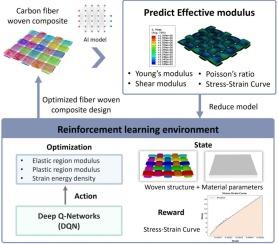基于集成深度学习和强化学习的人工智能驱动编织复合材料优化
IF 7.9
2区 材料科学
Q1 MATERIALS SCIENCE, MULTIDISCIPLINARY
引用次数: 0
摘要
编织碳纤维复合材料由于其卓越的强度重量比和可调的设计特点,越来越多地应用于先进的结构应用。然而,对其复杂编织结构的高保真模拟需要大量的计算。本研究提出了一种混合深度学习框架,该框架结合了用于机械性能预测的双输入卷积神经网络(CNN)和用于基于强化学习的优化的深度q -网络(DQN)。在弹性变形、塑性变形和应变能密度预测中,CNN的R2值均在0.96以上。使用DQN,优化设计的应变能密度提高了2.37倍,从3590.78 J/m3增加到8527.85 J/m3。此外,通过使用应力-应变行为的简化模型替换原始编织几何,模拟时间从534分钟减少到2分钟,速度提高了267倍。这种方法显著提高了复合材料设计和优化工作流程的效率,实现了高性能配置的快速探索。本文章由计算机程序翻译,如有差异,请以英文原文为准。

Ai-driven optimization of woven composite via integrated deep and reinforcement learning
Woven carbon fiber composites are increasingly adopted in advanced structural applications due to their exceptional strength-to-weight ratio and tunable design features. However, high-fidelity simulations of their complex woven architecture are computationally intensive. This study presents a hybrid deep learning framework that combines a dual-input Convolutional Neural Network (CNN) for mechanical property prediction with a Deep Q-Network (DQN) for reinforcement learning-based optimization. The CNN achieves R2 values above 0.96 for elastic deformation, plastic deformation, and strain energy density prediction. Using the DQN, the optimized design achieves a 2.37-fold improvement in strain energy density, increasing from 3590.78 J/m3 to 8527.85 J/m3. Furthermore, by replacing the original woven geometry with a reduced model using stress–strain behavior, simulation time is reduced from 534 min to 2 min, a 267-fold speedup. This approach significantly enhances efficiency in composite design and optimization workflows, enabling rapid exploration of high-performance configurations.
求助全文
通过发布文献求助,成功后即可免费获取论文全文。
去求助
来源期刊

Materials & Design
Engineering-Mechanical Engineering
CiteScore
14.30
自引率
7.10%
发文量
1028
审稿时长
85 days
期刊介绍:
Materials and Design is a multi-disciplinary journal that publishes original research reports, review articles, and express communications. The journal focuses on studying the structure and properties of inorganic and organic materials, advancements in synthesis, processing, characterization, and testing, the design of materials and engineering systems, and their applications in technology. It aims to bring together various aspects of materials science, engineering, physics, and chemistry.
The journal explores themes ranging from materials to design and aims to reveal the connections between natural and artificial materials, as well as experiment and modeling. Manuscripts submitted to Materials and Design should contain elements of discovery and surprise, as they often contribute new insights into the architecture and function of matter.
 求助内容:
求助内容: 应助结果提醒方式:
应助结果提醒方式:


